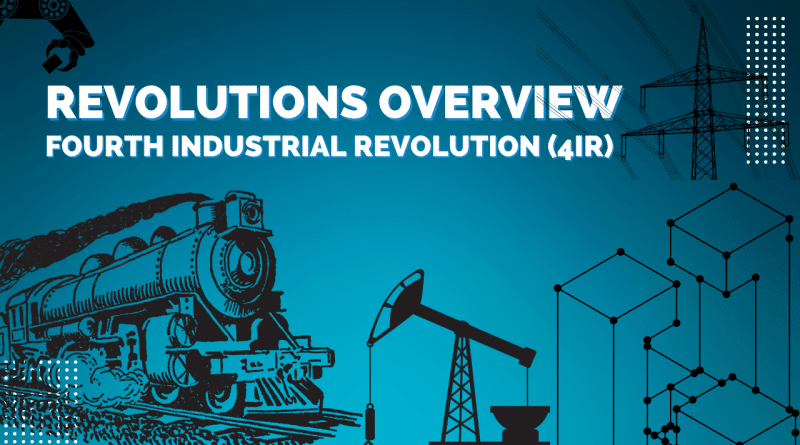Revolutions overview & Fourth Industrial Revolution (4IR)
Men has evolved over time. There was a time when men used to live in caves, that era is called the stone age. It was a very difficult life to live. Men gradually progressed. Human life changed. Men started to live in the societies. The people lived together and gradually passed the journey of development.
1st Industrial Revolution:
Thus, the process of development continued. Men was looking to create a source of comfort for them. But, this process of development was too slow. In the late 18th century, the steam engine has been invented and the concept of industrialization was created. Textile industries have been set up. Before that the men were making things manually with their hands, now the process was converting to machines in industries. The production was increased with less time. This was an important change in human life. At the same time, it created a lot of benefits but also started new problems for the men. This era is called the 1st Industrial Revolution. This was amazing progress in human development. After this, the process of development got pace.
2nd Industrial Revolution:
In the late 19th century, man has seen another outstanding change in their lives, when Electricity and Electric Bulb were invented. The fields of steel and petroleum were modernized. Airplanes and public transport have completely changed the way people travel before. Already existing industries have been renovated. There was an outstanding growth in the fields of oil, steel, and electricity. The methods of production have improved. Steel has replaced iron. Because the steel was stronger and cheaper than iron. By the use of steel, the network of railway tracks was laid. Steel has also been used in the production of ships. This led to the revolution in the field of transportation. This era is called the 2nd Industrial Revolution.
3rd Industrial Revolution:
After a century (in the 20th century), the world has witnessed another revolution. This is called the 3rd Industrial Revolution. It was the time when the world has entered in the digital era. Computer, Internet, etc have been invented. These made progress faster. New methods of business have been introduced. Revolution in the communication system has been made. New technologies have been introduced. With the help of these technologies, the 3rd Industrial Revolution has been opened the new door for Space Expedition, Research, and Biotechnology. Two important inventions in the Industrial World (Programmable Logic Controllers PLCs and Robots) got the world into the new heights of automation.
4th Industrial Revolution:
Now, let’s talk about the 4th Industrial Revolution. This is the revolution of present era (21st Century). In this revolution, the technologies like Artificial Intelligence (AI), Augmented Reality (AR), Internet of Things (IoT), 3D Printing, Blockchain, 5G Technology, etc. are changing the world in all aspects. Today, almost all the countries are trying to get these technologies and to get benefits from these in their national interests. These technologies will change the economy of the world in next few years. Some developed countries, that are leading the world in these technologies are strengthening their economies and lives of their people by using these outstanding and powerful technologies, and they are presenting new inventions more rapidly. The technologies of the 4th Industrial Revolution have completely changed the world. The methods of business have changed now. Automatic appliances have been introduced. Some of these 4IR Technologies are described below:
- Artificial Intelligence (AI):
Artificial Intelligence (AI) is a wide-ranging computer science branch dedicated to building smart machines that can perform tasks that typically require human intelligence. AI is a multi-approach interdisciplinary science, but advances in machine learning and deep learning are creating a paradigm shift in virtually every sector of the tech industry.
Artificial intelligence generally falls under two broad categories:
- Narrow AI
- Artificial General Intelligence (AGI)
- Internet of Things (IoT):
The Internet of Things, or IoT, refers to the billions of physical devices worldwide that are now connected to the internet, all of which capture and exchange data. Due to the advent of super-cheap computer chips and the omnipresence of wireless networks, everything can be converted into part of the IoT, from anything as small as a pill to anything as large as an airplane. Connecting and attaching sensors to all of these various items brings a degree of artificial intelligence to devices that would otherwise be dumb, allowing them to exchange data in real-time without involving a human being. The Internet of Things is making the world structure around us smarter and more open, integrating the physical and digital worlds.
- Blockchain:
Through using decentralization and cryptographic authentication, Blockchain, also referred to as Distributed Ledger Technology (DLT), makes the history of any digital asset unchangeable and transparent.
Google Doc is an easy analogy for understanding blockchain technology. If we create and exchange a document with a group of people the document is circulated instead of being copied or transferred. This creates a decentralized chain of distribution that simultaneously gives everyone access to the text. No one is locked out waiting for updates from another party, while all updates to the report are reported in real-time, making changes fully transparent.
Blockchain is, of course, more complex than a Google Doc but the comparison is apt as it highlights three important technology ideas:
Overview of Blockchain:
- Digital assets are distributed instead of copied or transferred.
- The asset is decentralized, allowing full real-time access.
III. A transparent ledger of changes preserves the integrity of the document, which creates trust in the asset.
- 3D Printing:
3D printing or additive fabrication is a method of producing solid three-dimensional objects from a digital image. A 3D printed model is produced using additive processes. An object is formed in an additive process by spreading out successive layers of material before the object is produced. One can see each of these layers as a thinly sliced horizontal cross-section of the eventual object. 3D printing is the opposite of subtractive production, in which a piece of metal or plastic with, for example, a milling machine is cut / hollowed out. 3D printing enables you to produce complex shapes using less material than traditional manufacturing methods.
4th Industrial Revolution and Pakistan:
If we talk about Pakistan, the present Government of Pakistan is serious to get 4th Industrial Revolution Technologies to Pakistan and get intense benefits from them in the national interests. For this purpose, with the complete collaboration of private sector, an institute has been established in 2018 namely Presidential Initiative for Artificial Intelligence & Computing (PIAIC). PIAIC is working under the leadership of The President of Pakistan, Mr. Dr. Arif Alvi. PIAIC is educating cutting-edge technologies to thousands of students.
“The mission of PIAIC is to reshape Pakistan by revolutionizing education, research, and business by adopting the latest, cutting-edge technologies. Experts are calling this the 4th industrial revolution. We want Pakistan to become a global hub for AI, data science, cloud-native computing, edge computing, blockchain, augmented reality, and internet of things”
Source: https://www.piaic.org/
This will create an outstanding impact on the economy of Pakistan as PIAIC goal is to increase digital exports of Pakistan to $ 5 Billion by the end of 2023. PIAIC will also utilize these technologies in the industries.
In today’s era, this reality can’t be rejected in any circumstance that if any country or nation wants to succeed in this modern world, they have to make them up in the 4IR Technologies. Their economies will not compete with the world. Their sovereignty may be challenged.






